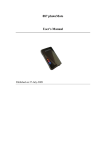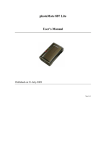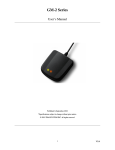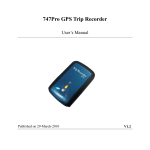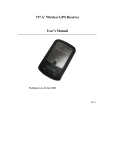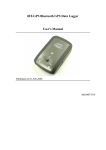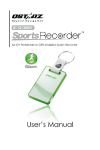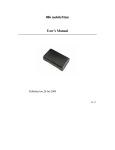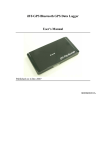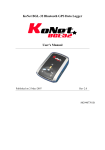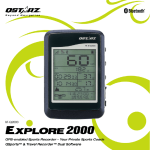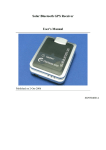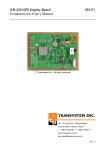Download 860E Users Manual
Transcript
860E Users Manual V1.0 Thank you for purchasing 860E 66-Channel GPS Datalogger. a. Package Content ● ● ● 860E x 1 USB to mini-USB cable x 1 Strap x 1 ● CD Tool x 1 (Software) b. Appearance & Led indications. 5. Power switch Blink every 2 seconds = Logging Always ON = Memory 90% occupied Blink every 5 seconds = Sleep mode Blink every 2 seconds = GPS fix Always ON = Searching for Satellite OFF = Sleep mode Always ON = Low battery Always ON = Charging battery OFF = Fully charged To turn ON/OFF the device 6. USB Port For power supply and data exchange 1. Log/Memory LED (RED) 2. GPS LED (Orange) 3. Battery status LED (Red) 4. Charge status LED (Green) c. Hardware function Built-in MTK II GPS High performance GPS solution with A-GPS for instant fix less than 15 seconds. Built-in 32Mb memory Capacity for up to 125,000 waypoints recording. Built-in 350mA Li-polymer battery for up to 11 hours operation time and 90 hours standby time. For automatically start/ stop logging and smart power management and waypoint saving. 860E will enter sleep mode when it is static for 2 minutes and recover when motion is detected. For power charging and data exchange. Use USB cable to connect to power source to charge the battery. Connect to PC to download the logged data or upload the A-GPS EPO data. *Connect to Laptop via USB cable to work as a wired GPS receiver. Log time interval will be changed according to the speed detected by the Device. Speed for each time interval can be programmed by the provided software. Built-in rechargeable Battery Built-in motion sensor (This function is turned on as default and can be turned off by the provided software.) Built-in Mini USB port Built-in Auto Gear function d. Product Specification GPS Chipset Frequency C/A Code Channels Antenna Datum General MTK 3329 L1, 1575.42MHz 1.023MHz chip rate 66-CH for tracking Built-in patch antenna with LNA WGS-84 Performance Characteristic Without aid: 3.0m 2D-RMS <3m CEP(50%)without SA(horizontal) Accuracy DGPS(WAAS,EGNOS,MSAS):2.5m Time 50 ns RMS Without aid:0.1m/s, Velocity DGPS(WAAS,EGNOS,MSAS):0.05m/s Cold/Warm/Hot 35/33/1 sec, average Position Altitude Velocity Acceleration Dynamic condition <18,000m <515m/sec 4G Environmental -10°C to +60°C -20°C to +80°C -10°C to +45°C 20% to 80% non-condensing Power Charging time 1.5hrs (Typical) Operation Time 11 hours Protocol NMEA-0183 (V3.01) - GGA, GSA, GSV, RMC (default) Data bit: 8, stop bit:1 (Default), Baud rate: 115200 Log data RCR, Date, Time, Fix valid, Latitude, Longitude, Altitude, Speed, Heading Physical Dimension 46 x 32 x 14.7mm Weight 22g Operating Storage Charging Relative Humidity Certification Others CE / FCC / C-tick e. Setup your 860E Install the software utility and driver for 860E. (System requirement) Minimum Configuration Recommended Configuration - Windows XP - Pentium 3, 500Mhz - 128M RAM - 400MB disk space - Network speed: 128Kbits/sec - 3D-capable video card with 16Mbytes of VRAM - 1024x768, "16-bit High Color" screen - Windows XP, or Vista - Pentium 4 2.4GHz+ or AMD 2400xp+ - 1G RAM - 2 GB of free disk space - Network speed: 768 Kbits/sec or better (DSL/Cable) - 3D-capable video card with 32 MB of VRAM or greater - 1280x1024, "32-bit True Color" screen f. How to connect 860E to your PC Step1. Find the software in the CD come with the package. Step2. Double click on the phototagger in the software utility folder and follow the process to finish the installation. Step3. User will be required to input the product key of phototagger at first time use. Product key can be found on the envelope of CD come with the package. Step4. Connect 860E to your computer with USB cable come with package and turn on the power of the device. ** Note! Please keep the product key in a safe place. ** Step5. Open phototagger and click on the “config GPS” button show in the below circled area to setup the device. Step6. Remove USB connection after finish the setup and switch on the power again and then you can enjoy recording of your trip. g. How to read data from the device. Step1. Connect 860E to your computer with USB cable come with package and turn on the power of the device. Step2. Open phototagger and click on the “Read from device” button show in the below circled area to start downloading data. Step3. [Note] To display track points on Google Earth, your PC must have Network to access the internet and Google Earth application. Google Earth installation (Download from http://earth .google.com/) [Notes and Warning] If you have recorded more than 125,000 waypoints in your 860E, it may take an entire resource of your computer to show all the logged data in Google Earth. Therefore, with not enough RAM capacity the computer may hang up (a system frozen). For detail use of phototagger --- Please refer to Help > User Manual show in the below circled area. h. Helpful tips ● ● ● ● ● ● ● It’s better to turn off 860E when you don’t use it, otherwise it might still keep recording data. Some vehicles having heavy metallic sun protecting coating on windshields may affect GPS signal receptions. Driving in and around high buildings may affect GPS signal receptions. Driving in tunnels or indoor park garage may affect signal receptions. In general, 860E performs best in open space where it can see clear sky. Also weather will affect GPS reception – rain & snow contribute to worse sensitivity. For the 1st time you use the 860E, it will take 1 to 3 minutes to obtain the satellite constellation information and fix your position, this is called “Cold Start”. If your 860E can’t fix your position for more than 20 minutes, we suggest you change to another spot with open space and then try again. *Google Earth is a trademark of Google. [Note] When you use AGPS function, we suggest using GpsView to download the AGPS data via USB cable. AGPS data will expire after 6 days. i. GpsView The GpsView program only supports Microsoft Windows XP, Vista and Win 7 OS. i-1. Driver Installation Connect 860E to PC with power turn on and then go to USB driver folder to click “InstallDriver.exe” to start the installation process. The device manager will assign a COM port for 860E after USB driver has been successfully installed. i-2. GpsView software Open GpsView software and select correct COM port and Baud Rate and then click “On” button to establish the communication between 860E and PC. If the connection is successful, the NMEA stream will keep showing. Cold, warm and hot start test button NMEA sentence Satellite reception Satellite No. i-3. Configuration In Setup Page, Output frequency of each NMEA can be changed from 1second to 5 seconds and Fix update–Rate can be changed from 1 time to 5 times per second. DGPS like WASS, EGNOS, MSAS can be enable or disable. Here also allow users to update the AGPS and record the NMEA sentence. NMEA output setting Record NMEA sentence Update rate setting Firmware version & name SBAS setting For example: + Fix update-rate = Real NMEA output GGA(1), GSA(1), GSV(1), RMC(1) GGA(1), GSA(1), GSV(1), RMC(1) GGA(1), GSA(1), GSV(1), RMC(1) NMEA output setting + + + 1 2 3 = = = GGA(1), GSA(1), GSV(1), RMC(1) GGA(1/2), GSA(1/2), GSV(1/2), RMC(1/2) GGA(1/3), GSA(1/3), GSV(1/3), RMC(1/3) GGA(1), GSA(1), GSV(1), RMC(1) + 4 = GGA(1/4), GSA(1/4), GSV(1/4), RMC(1/4) GGA(1), GSA(1), GSV(1), RMC(1) + 5 = GGA(1/5), GSA(1/5), GSV(1/5), RMC(1/5) Note: 1. GGA(1) means GGA sentence output every 1 second, GGA(2) output every 2 seconds. 2. GGA(1/2) means GGA sentence output 2 times per second, (1/5) output 5 times per second. i-4. Update AGPS Step1. Make sure you have network available for accessing the internet. Step2. Connect 860E to PC and then open GpsView to establish the communication. Step3. Go to “Setup” page Step4. Click “Update” button under AGPS to update the AGPS data. The program will connect to the AGPS server and download the data automatically. You can also check the valid time of AGPS by clicking Query. Clear AGPS data by clicking Reset. j. Free software from partners. - locr GPS Photo software. Please find the installation file for Windows in CD tool, or go to http://www.locr.com for further information. - HoudahGeo Please find the installation file for Mac in CD tool, or go to http://www.houdah.com for further information. k. Certification FCC Notices This device complies with part 15 of the FCC rules. Operation is subject to the following two conditions: 1. This device may not cause harmful interface, and 2. This device must accept any interference received, including interference that may cause undesired operation. FCC RF Exposure requirements: This device and its antenna(s) must not be co-located or operation in conjunction with any other antenna or transmitter. NOTE: THE MANUFACTURER IS NOT RESPONSIBLE FOR ANY RADIO OR TV INTERFERENCE CAUSED BY UNAUTHOURIZED MODIFICATION TO THIS EQUIPMENT. SUCH MODIFICATIONS COULD VOID THE USER’S AUTHORITY TO OPERATE THE EQUIPMENT CE Notice Is herewith confirmed to comply with the requirements set out in the Council Directive on the Approximation of the Laws of the Member States relating to Electromagnetic Compatibility (89/336/EEC), Low-voltage Directive (73/23/EEC) and the Amendment Directive (93/68/EEC), the procedures given in European Council Directive 99/5/EC and 89/3360EEC. l. Warranty information Thank you for your purchase of GPS product from the company. The company warrants this product to be free from defects in materials and workmanship for one year from the date of purchase. The warranty for accessories is six months. The stamp of distributor or a copy of the original sales receipt is required as the proof of purchase for warranty repairs. The company will, as its sole option, repair or replace any components, which fail in normal use. Such repair or replacement will be made at no charge to the customer for parts or labor. The customer is, however, responsible for any transportation costs. This warranty does not cover failures due to abuse, misuse, accident or unauthorized alteration of repairs. The company assumes no responsibility about products which have been improperly used, abused, damaged due to accident or natural disaster, or damaged due to unauthorized disassembly, repair or modification.







